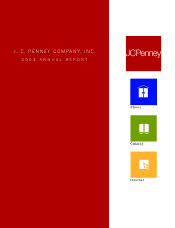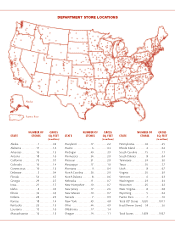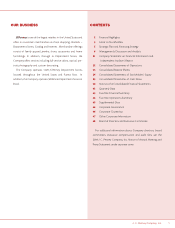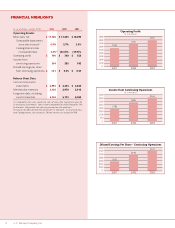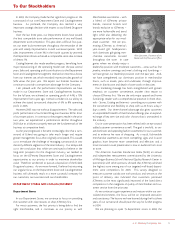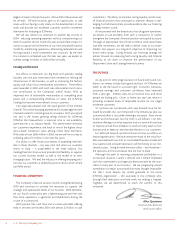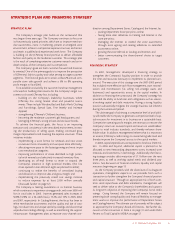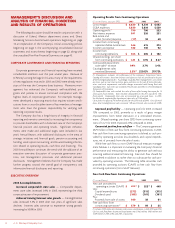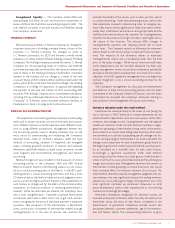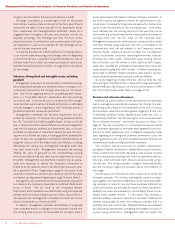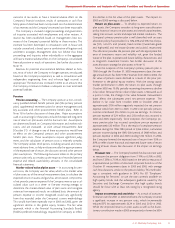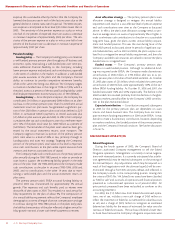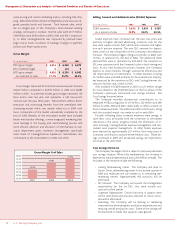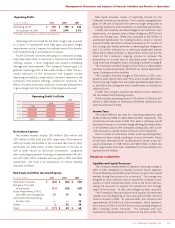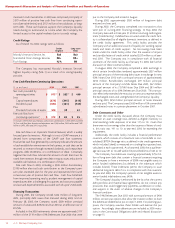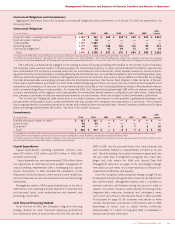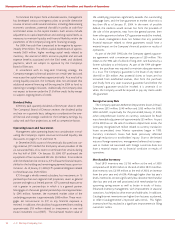JCPenney 2003 Annual Report Download - page 9
Download and view the complete annual report
Please find page 9 of the 2003 JCPenney annual report below. You can navigate through the pages in the report by either clicking on the pages listed below, or by using the keyword search tool below to find specific information within the annual report.
J. C. Penney Company, Inc. 7
Management’s Discussion and Analysis of Financial Condition and Results of Operations
Strengthened liquidity — The Company ended 2003 with
approximately $3.0 billion of cash and short-term investments, in
excess of 55% of the $5.4 billion outstanding long-term debt. The
cash balance continues to provide liquidity and flexibility during
the Company’s turnaround.
HOLDING COMPANY
Effective January 27, 2002, J. C. Penney Company, Inc. changed its
corporate structure to a holding company format. As part of this
structure, J. C. Penney Company, Inc. changed its name to
J. C. Penney Corporation, Inc. (JCP) and became a wholly owned
subsidiary of a newly formed affiliated holding company (Holding
Company). The Holding Company assumed the name J. C. Penney
Company, Inc. All outstanding shares of common and preferred
stock were automatically converted into the identical number and
type of shares in the Holding Company. Stockholders’ ownership
interests in the business did not change as a result of the new
structure. Shares of the Company remain publicly traded under the
same symbol (JCP) on the New York Stock Exchange. The Holding
Company is a co-obligor (or guarantor, as appropriate) regarding
the payment of principal and interest on JCP’s outstanding debt
securities. The Holding Company and its consolidated subsidiaries,
including JCP, are collectively referred to in this Annual Report as
"Company" or "JCPenney," unless indicated otherwise. See Basis of
Presentation in Note 1 on page 26 for further discussion.
CRITICAL ACCOUNTING POLICIES
The application of accounting policies necessarily involves judg-
ment and, in certain instances, the use of estimates and assump-
tions. Different amounts could be reported under different condi-
tions or using different assumptions. Management believes that
the accounting policies used to develop estimates that are the
most critical to understanding and evaluating the Company’s
reported results relate to: inventory valuation under the retail
method of accounting; valuation of long-lived and intangible
assets, including goodwill; estimation of reserves and valuation
allowances, specifically related to closed stores, insurance, income
taxes, litigation and environmental contingencies; and pension
accounting.
Revenue recognition was included in the discussion of critical
accounting policies in the Company’s 2002 and 2001 Annual
Reports; however, based on the following analysis it is not includ-
ed as a critical accounting policy in this Report. In the SEC’s pub-
lished guidance, a critical accounting estimate is one that is both
(1) material due to the levels of subjectivity and judgment neces-
sary to account for highly uncertain matters or the susceptibility of
such matters to change; and (2) the effect of the estimate and/or
assumption on financial condition or operating performance is
material. While net retail sales are material, the Company’s busi-
ness is fairly straightforward. Customers purchase merchandise
and services with credit or debit cards, cash or gift cards, and rev-
enue is recognized at the point of sale when payment is made and
customers take possession of the merchandise in department
stores, at the point of shipment of merchandise ordered through
Catalog/Internet, or in the case of services, the customer has
received the benefit of the service, such as salon, portrait, optical
or custom decorating. Other than estimating returns, there is very
little subjectivity involved in determining when to recognize rev-
enue. Sales returns are not significant for retail stores due to the rel-
atively short timeframe in which returns are typically made and the
visibility of the merchandise to the customer. For Catalog/Internet,
however, the return period is longer and return rates higher due to
the nature of the business. The January 2002 changes in
Catalog/Internet payment and shipping policies led to lower
return rates. The Company records an allowance for estimated
returns based on the returns policy in place and historical experi-
ence. The majority of the allowance relates to estimated
Catalog/Internet returns and is considerably lower than the level
prior to the policy changes. While returns have historically been
within expectations and the recorded allowance has been ade-
quate, management reviews actual return experience periodically
and adjusts the allowance, as appropriate. As a result of this recon-
sideration of the SEC’s guidance, management has concluded that
revenue recognition is not a critical accounting estimate for the
Company.
The Company’s management has discussed the development
and selection of these critical accounting policies with the Audit
Committee of the Company’s Board of Directors, and the Audit
Committee has reviewed the Company’s disclosures relating to
these policies in this Management’s Discussion and Analysis.
Inventory valuation under the retail method:
Inventories are valued primarily at the lower of cost (using the
last-in, first-out or "LIFO" method) or market determined by the
retail method for department store and store support center (SSC)
inventory, and average cost for Catalog/Internet and the regional
warehouse inventory. Under the retail method, inventory is segre-
gated into groupings of merchandise having similar characteristics
and is stated at its current retail selling value. Inventory retail values
are converted to a cost basis by applying specific average cost fac-
tors for each grouping of merchandise. Cost factors represent the
average cost-to-retail ratio for each merchandise group based on
the beginning of period inventory plus the period’s purchase activ-
ity, as calculated on a monthly basis, for each store location.
Accordingly, a significant assumption under retail method
accounting is that the inventory in each group of merchandise is
similar in terms of its cost-to-retail relationship and has similar gross
margin and turnover rates. Management monitors the content of
merchandise in these groupings to ensure distortions that would
have a material effect on inventory valuation do not occur. The
retail method inherently requires management judgment and cer-
tain estimates that may significantly impact the ending inventory
valuation at cost as well as gross margin. Among others, two of the
most significant estimates are permanent reductions to retail
prices (markdowns) used to clear unproductive or slow-moving
inventory and shortage (shrinkage).
Permanent markdowns designated for clearance activity are
recorded at the point of decision, when the utility of inventory has
diminished, versus the point of sale. Factors considered in the
determination of permanent markdowns include: current and
anticipated demand, customer preferences, age of the merchan-
dise and fashion trends. The corresponding reduction to gross

